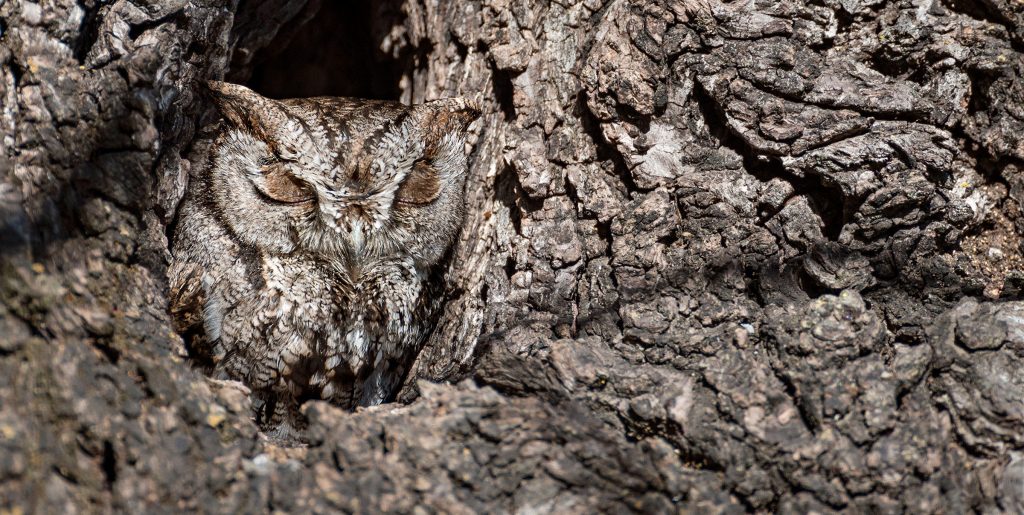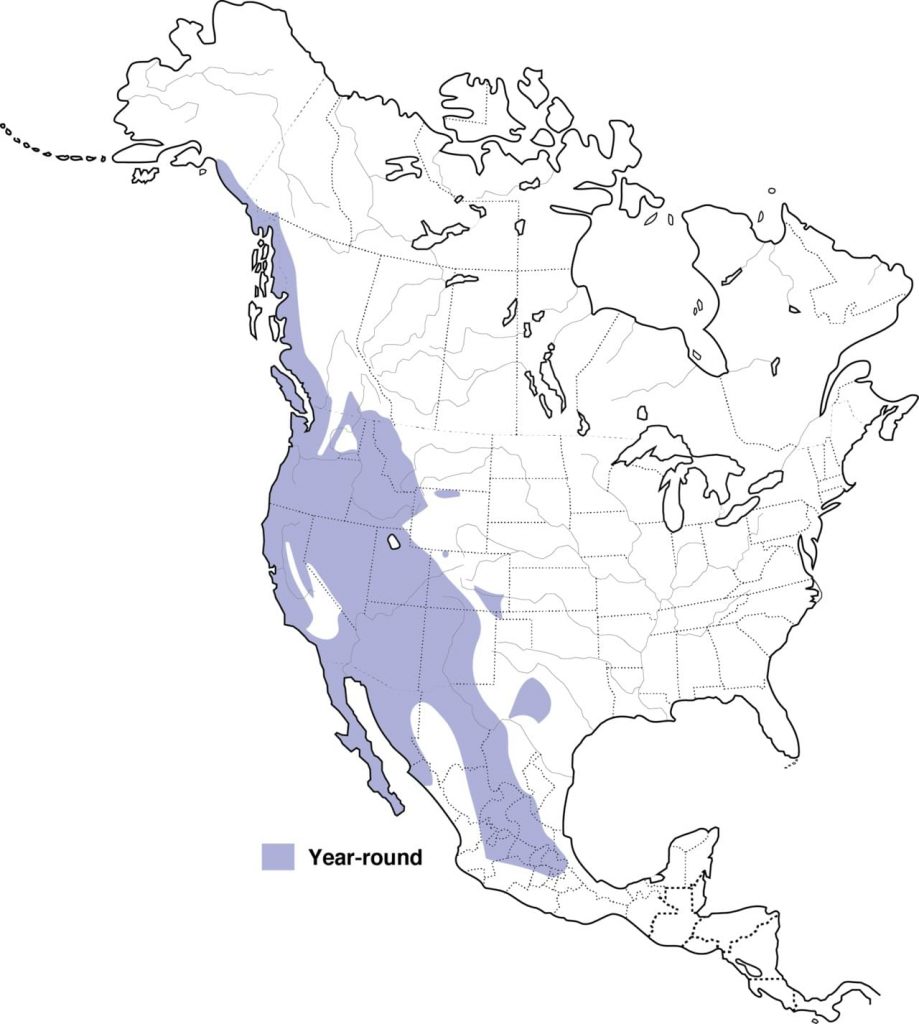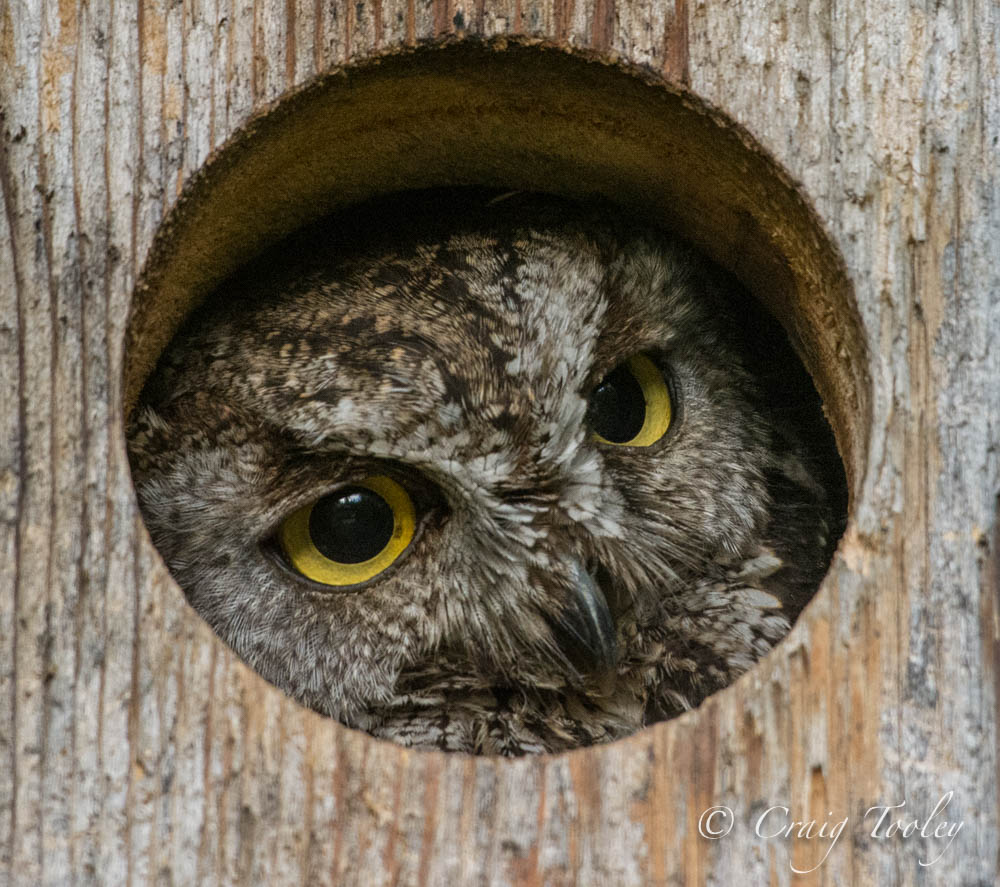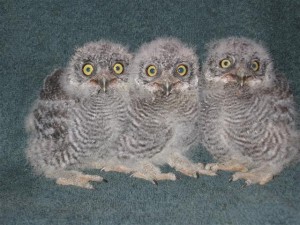Part One: Introduction
The western screech owl (Megascops kennicottii) is a robin sized owl who packs quite a punch. Standing only 7 to 10 inches tall, this owl can still hold its own next to the much larger members of the owl (Strigidae) family. On occasion they can be seen taking down prey much larger than themselves, including cottontail rabbits and even mallards (The Cornell Lab of Ornithology). Although often hard to see because of its excellent camouflage this bird can be identified by its small stocky build, distinct ear tufts and yellow eye colour (COSEWIC). Brown, grey or rufous in colour with vertical stripes on its underbelly this owl blends in excellently with the bark on the trees in its habitat (The Cornell Lab of Ornithology).


This little guy can be found along the coast of North America and into the southern interior of British Columbia, including Kamloops. It’s territory extends through the coast and mountain valleys of the interior United States, reaching all the way to north western Mexico (The Cornell Lab of Ornithology).
The western screech owl is non migratory and remains in the same territory year round. It does not need to migrate due to its generalist nature. The western screech owl can feed from a large variety of sources including small mammals, insects, fish and even small birds. It is found in heavily forested areas where it nests and roosts in tree cavities (Campbell 2013).
The name “screech owl” is a misnomer for this bird whose call is more a series of toots in the pattern of a bouncing ball. “Screech” is better suited for the eastern screech owl, another member of the Megascops genus (The Cornell Lab of Ornithology).
Although the species as a whole is not considered “at risk”, local populations are threatened due to their habitat also being prime real estate for human populations. Deforestation as well as removal of dead trees by humans has significantly decreased the number of optimal nesting sights for western screech owls. This is seen in the decreasing population of the western screech owl in the metro Vancouver and Southern Vancouver Island areas which is thought to be due to the increasing development in these regions (COSEWIC).
A way you can help conservation efforts in these regions is to provide nesting boxes in your yard. An optimal nest box for these owls should be 10-30 feet off the ground, made of reclaimed wood and East or South facing. The entrance hole should be 3 inches in diameter, have a height of at least 14 inches and be 10 inches deep and 11 3/4 inches wide. More tips on building your own nest box can be found at https://nestwatch.org/learn/all-about-birdhouses/birds/western-screech-owl/.

A fact that I found particularly interesting about this bird is that after hatchlings leave after 28 days in the nest, both parents continue to care for their young for another 5-6 weeks (Audubon). This is likely because owlets cannot fly immediately after they leave the nest and therefore still need help when it comes to feeding and protection from predators. They gain the ability to fly and become independent at around 8-10 weeks after leaving the nest (Songbird Garden). All our lives we are taught of the “tough love” approach to parenting that birds have, of them pushing their young out of the nest, and only the strong survive. This is why I personally find parental care in these birds so interesting. However, after some research I have found parental care is not particularly unusual birds and is seen in many species (Cockburn 2006).

These raptors, tiny but mighty are an important species which deserve to be protected. Constant urbanization has become a threat to this beautiful bird, but there are still things that can be done to help the population flourish. On an individual level, providing nest boxes is an excellent way to help, however, more needs to be done on an industrial scale for the conservation of this species among many others. The consistent growth of human civilization is inevitable but I hope in the future it is done with more consideration and care for the species’ it impacts. With this I hope that western screech owls can be seen and enjoyed for generations to come.
Part Two: Dispersal of Juvenile Western Screech Owls
An area of interest for western screech owls is when, why and how they disperse. Specifically whether dominant or subordinate juveniles disperse first. There was an experiment done by Ellsworth and Belthoff to determine the correlation between dominance and dispersal time. western screech owls are a prime species to observe for this behaviour because of their use of nest boxes. The birds were observed from hatching and their dominance status was determined throughout their time in the nest. This was determined using a system of “wins and losses” whenever there was a physical contact between two fledglings that was considered aggressive. Although not overtly aggressive with each other, they did engage in a series of pecks, shoves and displacements. Using this system of wins and loses they create a scale of most to least dominant fledgling (Ellsworth and Belthoff).

Dispersal distances between the most dominant and most subordinate fledglings were compared. During the determination of the dominance rankings it was found that females were the most dominant in most of the broods observed, this is thought to be due to their larger body size. (Ellsworth and Belthoff 2015)
It was found that the most dominant fledglings dispersed first with the most subordinate dispersing about 2 months after the first fledgling. Interestingly, they often left in the order of dominance the researchers had determined. The researchers determined this to be because of dominant owlets developing faster and becoming independent sooner. Moreover, in broods with smaller clutch sizes it was found that the most subordinate fledgling left sooner on average than those in larger clutch sizes. This can be inferred to be because of a decrease in competition between brood mates, and therefore quicker development and independence (Ellsworth and Belthoff 2015). This experiment allows researchers to have a better understanding of why and when western screech owl fledglings disperse which can have huge impacts when it comes to rehabilitation and release of abandoned owlets. The more we know about their natural cycles, the better we can assist them and prepare them for life outside the nest.
References
Audubon: Guide to North American Birds (n.d). Retrieved October 20, 2019. https://www.audubon.org/field-guide/bird/western-screech-owl
Campbell, S. (2013, May 01). Western screech owl hit by car recovering at north island wildlife recovery centre. Alberni Valley Times Retrieved from: https://search-proquest-com.ezproxy.viu.ca/docview/1347736314?accountid=12246
Cockburn A. (2006). Prevalence of different modes of parental care in birds. Proceedings. Biological sciences, 273(1592), 1375–1383. Retrieved from: https://www.ncbi.nlm.nih.gov/pmc/articles/PMC1560291/?tool=pmcentrez&report=abstract
Committee on the Status of Endangered Wildlife in Canada: Assessment and Status Report on the Western Screech-Owl kennicottii subspecies Megascops kennicottii kennicottii and the Western Screech-Owl macfarlanei subspecies Megascops kennicottii macfarlanei in Canada (2012). Retrieved from https://www.sararegistry.gc.ca/virtual_sara/files/cosewic/sr_western_screech-owl_1012_e.pdf
Cornell Lab of Ornithology: All About Birds (n.d). Retrieved October 20, 2019. https://www.allaboutbirds.org/guide/Western_Screech-Owl/overview
Ellsworth E. A; Belthoff J.R. (1999). Effects of social status on the dispersal behaviour of juvenile western screech-owls. Animal Behaviour, 57(4), 883-892. Retrieved from: https://www-sciencedirect-com.ezproxy.viu.ca/science/article/pii/S0003347298910508
NestWatch: Where Birds Come to Life (n.d). Retrieved October 20, 2019. https://nestwatch.org/learn/all-about-birdhouses/birds/western-screech-owl/
Songbird Garden (n.d). Retrieved October 20, 2019. https://www.songbirdgarden.com/store/info/infoview.asp?documentid=183
Hi Emma,
What a cute bird! I loved the comparison of the Western and Eastern Screech Owl calls, way too cute! I am always so amazed by their incredible camouflage ability, it’s very impressive.
I found it interesting that these guys have been recorded taking down Mallards; in my head I imagine them in completely different environments! They really are tough little birds!
I’m curious at how effective putting up Western Screech Owl nest boxes in our yards would be? Do you think other owl species would end up taking over these boxes rather than the intended target? I read the NestWatch link you put up, and it states that “pairs nesting in suburban habitats are generally tolerant of humans close to their nests,” but it feels like these owls generally avoid suburban areas all together? I know in my neighbourhood we have a healthy Barred Owl population and a few Great Horned so I don’t know how invited Western Screech Owls would feel even though there is some decent forested habitat around. Would adding nest boxes be more beneficial if you already knew you had screech owls on the property? So many questions, sorry about that!
Thanks!
Sam
Hi Sam,
Thanks for taking the time to read my blog! I really appreciate the great questions.
I did some more research on the nest boxes and found that the foundation Habitat Acquisition Trust has been putting up nest boxes in areas that are already suitable for screech owls in terms of food availability and cover, but just don’t have any natural cavities for the screech owls to nest in and it seems to be working. This leads me to believe that this is an attempt to provide somewhere new for the western screech owls to nest where barred owls and other competitors haven’t been observed. These nest boxes they have been putting up, as well as the ones described in my post only have a 3″ opening, so not big enough for a barred owl and because of the lack of other suitable nesting sites, hopefully keep the barred owls away and provide a safe habitat for the western screech.
So to answer your question, I believe these next boxes would most valuable and helpful close to a forested area as well as in an area not already dominated by barred owls. So if you live in a more rural area, for example Cowichan or Nanoose and haven’t noticed any barred owls or other competitors in your area it may be worth a shot to put up a nest box and wait for some western screech owls to move in 🙂
Thanks,
Emma
Hey Emma,
Awesome blog! Such adorable birds. I definitely made some pathetic whimpering sounds watching the last video- they are so darn precious.
I was wondering if you knew anything about the western screech owl defense mechanisms against predation. Since they’re so small and inhabit a lot of the areas with larger raptors, I would think they’d often make a good snack for a larger bird. It looks like their camouflage works very well, but do they do anything else to keep themselves and their owlets safe?
Thanks for all the newfound knowledge!
Shenade
Hey Shenade,
I read a lot about these little guys being quite aggressive, often attacking humans who get too close to their nests. So clearly they can put up quite a fight but I couldn’t find much info on how exactly they defend these nesting sites. A lot of times they will issue a warning call from their nest to warn predators that they will attack and this can often prevent an attack altogether.
Other than that I couldn’t find much information on exact defensive behaviours. I did find a video of an eastern screech owl getting in a fight with a squirrel. It puffs up and opens it’s wings to make itself look larger then appears to fly at the squirrel feet first and then the fight was over. The eastern and western screech owls are very closely related so it’s possible they have the same defence tactics. Here’s a link to the video I found if you’re interested
https://youtu.be/wUNiT0AwMBU
Thanks for the great question!
Cheers,
Emma
Hey Emma!
These little puffs have a near and dear place in my heart so I thoroughly enjoyed reading your blog! My question is similar to Sam’s, while the nest boxes would be helpful when used appropriately I agree that other species will likely show interest in them as well, do you know of any other methods that local government or others are taking to help these little hooters? Since they are not considered an at-risk species per se I would imagine they don’t get much attention which is a shame.
Thanks!
Em
Hi Em,
Thanks for taking the time to read my blog.
During my research I didn’t find much about the government specifically doing anything to help these little guys other than calling upon landowners to use nest boxes to help house them. One of my sources, a government document, even goes so far as to provide a specific plan on how to build a nest box but it doesn’t seem like they are doing much themselves. A foundation called the Habitat Acquisition Trust however is actively building nest boxes for these but they are a non-profit organization and not the government. So unfortunately no help from Canada for these guys 🙁
Thanks!
Emma
Hey Emma, great blog! I love WESO’s and their interesting calls.
I also found it quite interesting that the subordinate fledgling always leaves last but after different durations of time based on size of the clutch.
In regards to parental care, do you know why the owlets leave the nest so early even though they still receive parental care for an additional 5-6 weeks after they leave?
Once again, great blog!
Mason Friman
Hey Mason,
Thanks for taking the time to read my blog!
I couldn’t find any reason during my research as to why they push them out of the nest when they are so obviously not prepared to live outside of the nest and constantly need parental care. Perhaps they grow too big for the nest, as they can have up to 6 hatchlings at a time. It would make sense that they might grow too big and must leave the nest and run around on branches and the ground even though they can’t fly yet. However, that is just speculation!
Thanks,
Emma
Hi Emma,
Such a great and informative blog! I also found that fact about the high extent of parental care after the chicks leave the nest super interesting! I was just wondering if you’ve found out anything on how many broods these guys can have in a year, especially if the parents are investing so much effort per brood?
Thanks,
Gen
Hi Gen,
Thanks for taking the time to read my blog!
All research I’ve done says that they only have one brood per year of 2-6 chicks, which hatch around April. This makes sense with how much parental care goes into their chicks. They wouldn’t have enough energy or resources to have more than one brood per year.
Thanks,
Emma